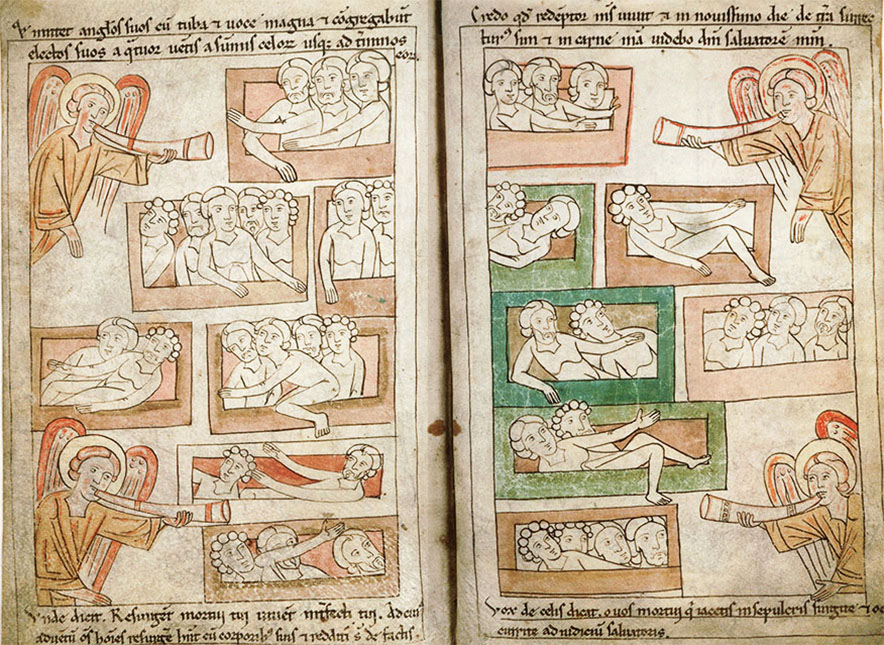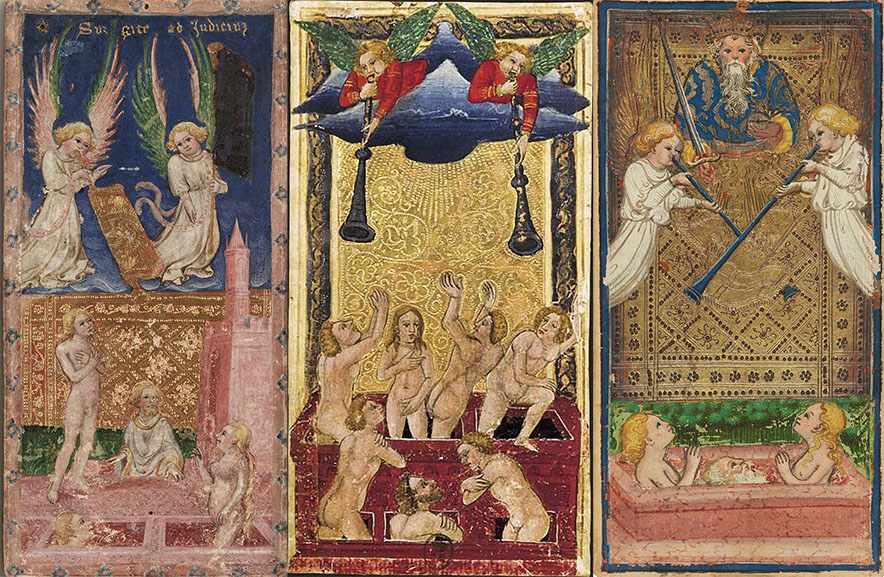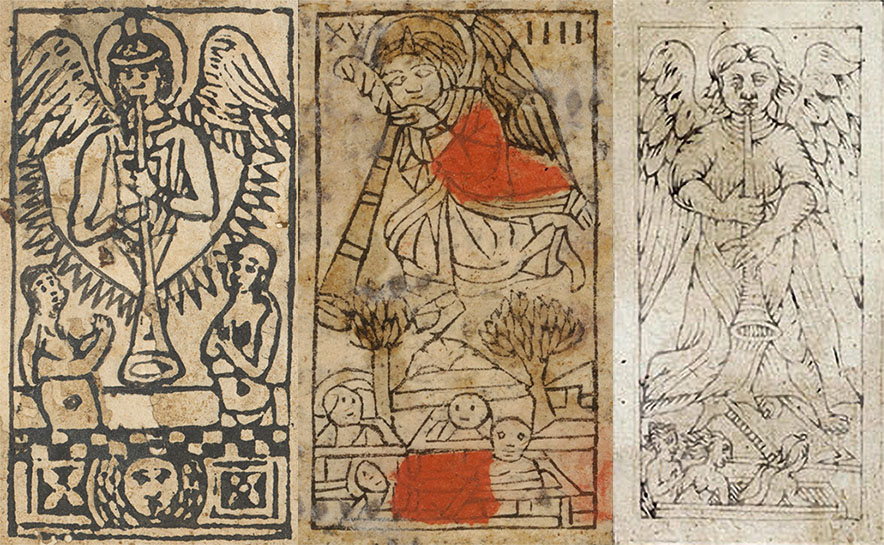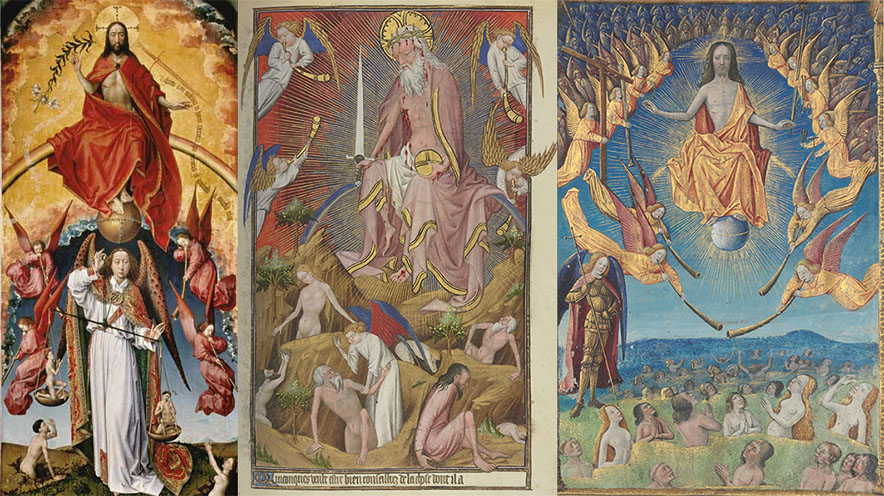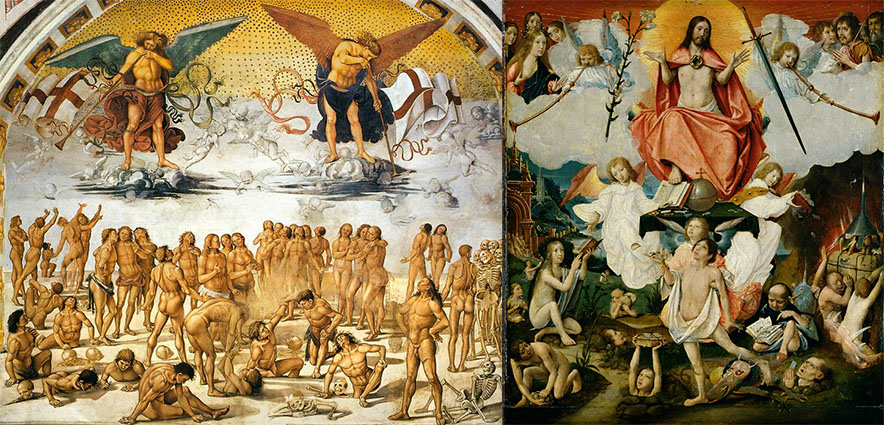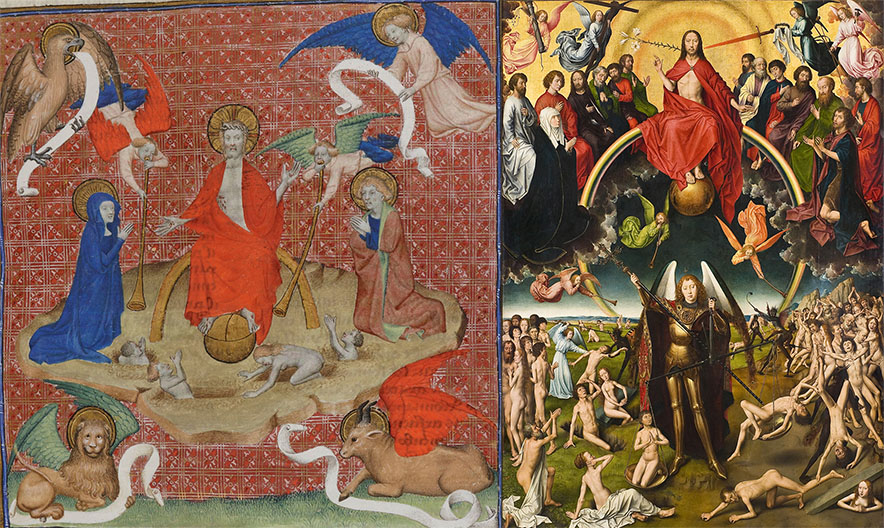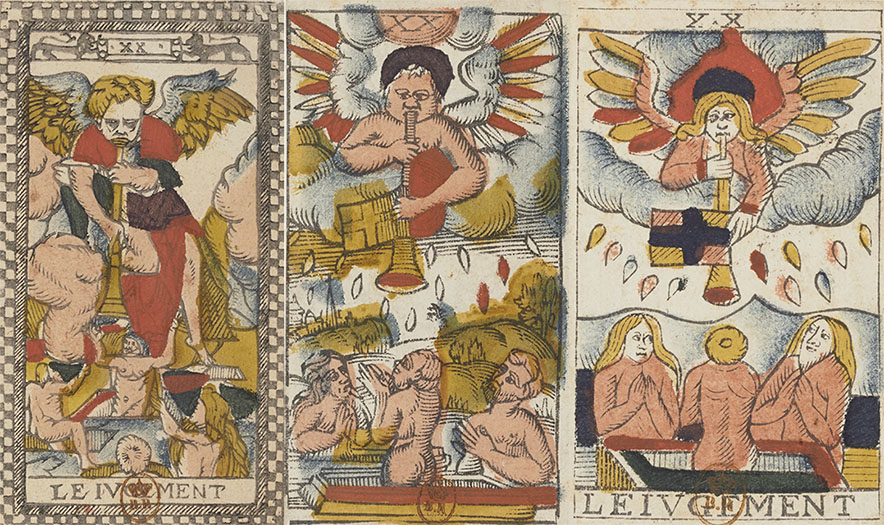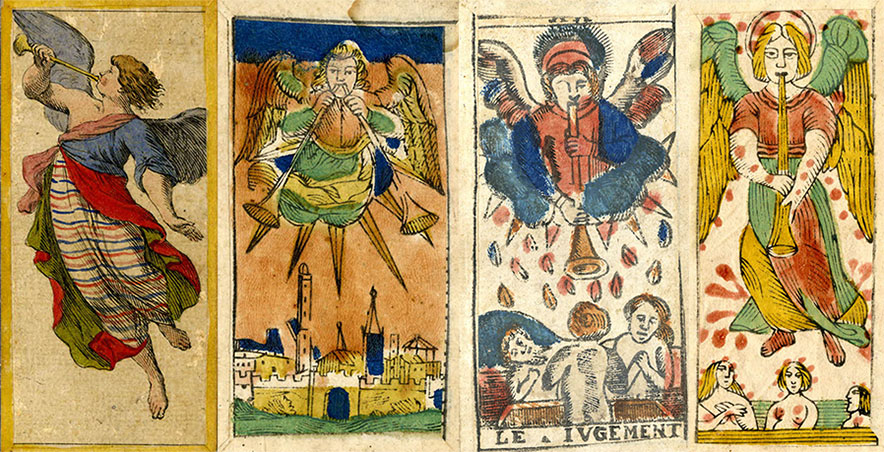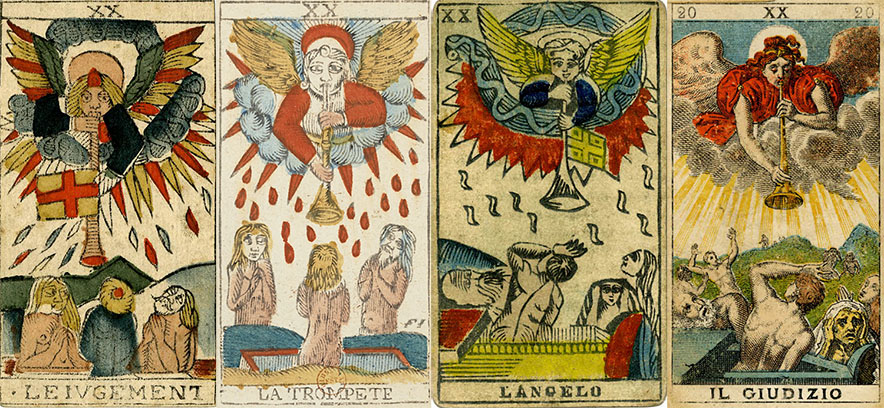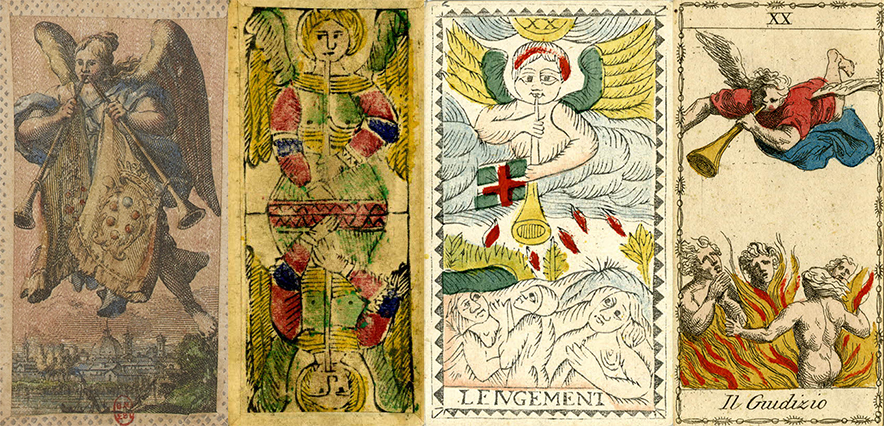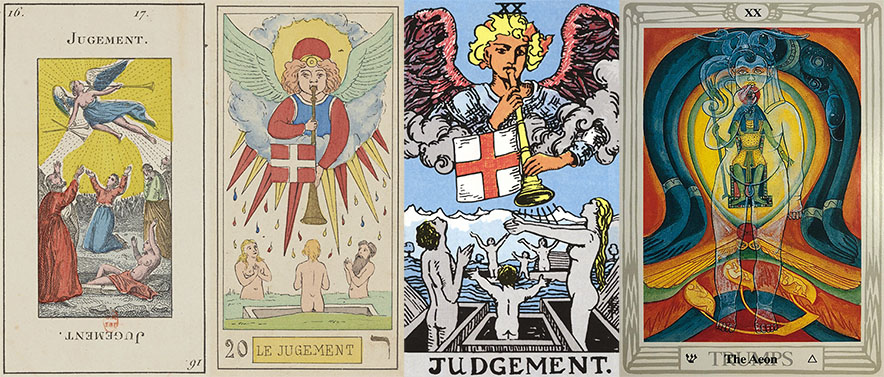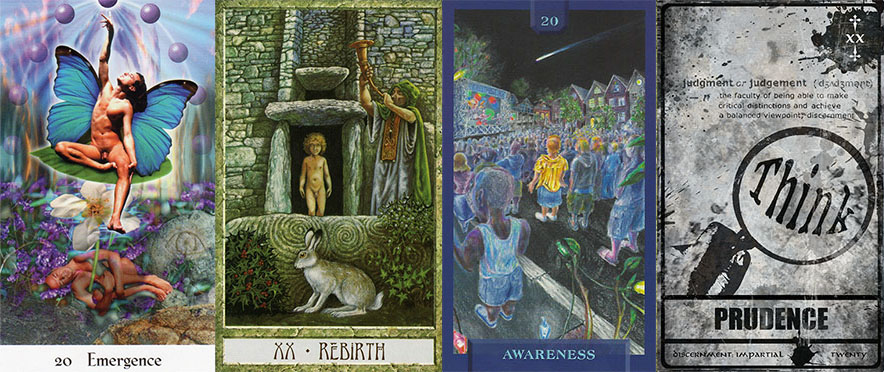THE TAROT WHEEL
LO ANGELO - THE ANGEL
To start the journey through time with the Judgement card, I'll show you a detail of an illustration of the 12th Century French manuscript, made in Amiens, called the Bible of Pamplelune. It is a beautiful example of medieval art. This image illustrates very well the essence of the card, the resurrection of the dead for the last judgement, and the source of inspiration, the Bible. We see four winged angels blowing on a trumpet. In the center of the image, the dead are resurrecting from their tombs. Many Tarot cards have different sources of inspiration, the inspiration for this card is purely Christian, based on the book of Revelation in the Bible. The card was originally called the Angel, before it became known as the (last) Judgement. Let us first see how this theme was represented on the different surviving hand-painted cards. Four cards survived, three of them are shown here below.
From left to right, we have the Judgement card from the 1442 Milanese Visconti di Modrone deck, the hard to date Ferrarese Charles VI deck and the 1475-1490 extension of the 1452-1454 Visconti Sforza deck. The not shown 4th surviving card is from the Van Bartsch collection. This card dates from the end of the 15th Century and is based on the Visconti Sforza deck. A poor quality photo of the card is shown on page 101 of the first volume of the Kaplan Encyclopedia of Tarot. According to Kaplan, the card has been sold to a Milanese private collector and no better quality images of this card are known.
On the Visconti di Modrone card, we see two angels with trumpets, one is blowing the trumpet to resurrect the dead. Three people rise out of their tomb under the eyes of Jesus Christ. On the top of the card is written "surgite ad judicium" (rise for judgement). On the banners of the angels, we see family emblems of the Visconti (a dove against a radiant sun on the golden banner) and the Sforza (the fountain of life on the dark banner) families. We cannot underestimate the importance of this card for the understanding of the development of the Tarot structure that was not fixed yet when this deck was created. The Milanese Visconti di Modrone deck had probably only 16 trump cards, while at the same time in Ferrara a 14 trump structure prevailed. And in this 14 trump structure, there was no place for the Judgement card. In Milan finally the 14 trump structure was adopted, so the Brera-Brambilla deck and the original Visconti Sforza deck has only 14 trumps and no judgement card. Around 1460 the future Duke Ercole I of Este came back to Ferrara at the age of 29 years after an education period of fifteen years at the Neapolitan court. His return probably gave the discussion about the trump structure a new impulse, and several years later the first Trionfi deck with 22 trumps appeared in Ferrara. This structure included the judgement card. We can conclude that the development of the 22 trump structure was not the work of one person or one group of savants. The Milanese and Ferrarese courts had a good relation, and probably there was a vivid discussion between several people at both courts about the trump structure. As a result of these discussions, the Milanese proposition to include the Judgement card was retained in the final trump structure.
The second image, the Judgement card from the Charles VI deck, was one of the first decks with this new 22 trump structure. Here we see two angels awakening the dead.
The third card is from the Visconti Sforza deck. Two angels are wakening the dead with their trumpets. On their trumpets two banners, one with the radiant sun and the other with a cross. This banner with a cross reminds us the banner with which the resurrected Christ is often shown, a red cross on a white background meaning victory over death. Three people are rising from the tomb. Above the two angels a bearded crowned old man, holding in his right hand a sword pointing to the air and in his left hand an orb of power. The sword symbolizes the decisions the old man is making, and the orb his power. It could very well be that this old man is a personification of either God the Father or Jesus Christ. Once the 22 trump structure adopted by the Italian nobility, at least six cards are added to the Visconti Sforza deck to complete the structure, probably somewhere between 1475 and 1490. The Judgement card was part of this extension. This card has a lot of similarities in style with the Visconti di Modrone card, so it could very well be one of the last works of Bonifacio Bembo, who died in 1477.
Now let us have a look at the printed Judgement cards created around 1500.
Three cards derived from uncut sheets found in ancient book bindings during restoration work. From left to right we have the Judgement card from the Rosenwald sheet, the Budapest sheet and the Rothschild sheet. The first two drawings are very primitive, the third one is from a much better quality. On all three cards, one angel calling the dead to rise for judgement. In spite of the much lower quality, the message stays untouched, and the scene is identical in composition to the Charles VI deck, with only angels and dead people rising from their tomb. In contrary to the previous cards, where standardization was far to seek, here all cards represent exactly the same scene, an angel blowing the trumpet and the dead rising from their tombs. How this scene was represented in Renaissance art? Many great painters were inspired by the Last Judgement. The most famous is painted by Michelangelo. There is a lot of symbolism in detail, and we see human souls rising to Paradise or descending to Hell. Other painters like Giotto and Giovanni da Modena made also monumental painting from the last judgement, but they focus themselves on creating a representation of Hell and Paradise. None of these works incorporates the call to rise for judgement, all of them focus themselves on what happens with the human souls after judgement. Let us start with some works that show the resurrection.
From left to right, we have a detail of the Beaune altarpiece, created between 1445 and 1450 by the Flemish painter Rogier van der Weyden, a miniature from the Grandes Heures de Rohan, created between 1418 and 1435 by the master of the Rohan hours in Angers and finally a miniature from the Heures de Louis de Laval, created between 1470 and 1485 by Jean Colombe. The Beaune altarpiece is the major achievement of Rogier van der Weyden. It consists of 9 panels, of which 6 are painted on both sides. We see here the central panel that shows four angels awakening the dead, the archangel Michael who is weighing each human soul and Jesus Christ, sitting on a rainbow with his feet on an orb, in judgement. The other front-side panels, show a continuous landscape with on the far left (from the viewer's viewpoint) the gates of Heaven and on the far right the Entrance of Hell. The concept of weighing the souls is not from the Bible, it appears for the first time in a Christian text in the second century. In the Bible, Revelation 20:12, the human soul is judged according to his book of life. In the center, the dead are rising from their graves, and on the other panels they are depicted travelling from the central panel to their final destinations after receiving judgement. In the Rohan hours, we see four angels blowing on trumpets and one angel helping the dead to rise from their graves. Between the angels, we see an old man, who can clearly be identified as Jesus Christ, with exactly the same sword and orb of power as depicted on the Visconti Sforza card. Also here he is sitting on a rainbow. On the third image, we see again four angels blowing on trumpets. Jesus Christ is here in exactly the same position as on the first image, sitting on a rainbow with his feet resting on an orb. Many souls are rising from their grave and the Archangel Michael is supervising this action. Let us see two more examples:
The two images here above are from the very start of the 16th Century. The first image is painted in 1502 in the Orvieto cathedral. It depicts a resurrection scene with two scarcely clothed male angels blowing a trumpet and many dead rising from their grave. On the trumpet of the angels, we see a white banner with a red cross, symbolizing victory over death. The second painting is painted by Jan Provost somewhere after 1505. Again we see angels blowing a trumpet and dead people rising from their grave. Jesus Christ is sitting between the two angels. Below Jesus an orb of power and under his right foot the book of life, based on which he decides who is going to Hell and who is accepted in Heaven. Two more images before we return to the Tarot cards
The first image is an illustration from a French manuscript from the end of the 14th Century that is a translation by Raoul de Presles of a 13th Century Latin manuscript called Saint Augustin, De Civitate Dei. Again we see two angels waling the dead and Jesus Christ sitting on a rainbow with his feet resting on an orb. In the four corners the four living creatures described in Revelation 4:6-8, a lion, an or a man and an eagle. Remark that they are shown in an inverted (left <-> right) configuration with respect to the Tarot of Marseille World card. The second image is a painting made by Hans Memling in 1470. The scene is identical in composition to the Beaune altarpiece, with some added details. Jesus is surrounded by his 12 apostles, Joseph and Maria. On the ground, we see that while Michael is weighing the human souls, devils are trying to snatch them independently of the judgement of Jesus. Other angels are there to obstruct this attempt.
I could show many more examples, but in essence they are all the same. The resurrection of the dead is deeply rooted in Christian culture and very early this has crystallized in a certain representation that did not change anymore. The differences between the illustrations are guided by available space, the technique used and the technical skill of the artist. Let us see if this counts also for Tarot cards in the following Centuries.
From left to right, the anonymous Tarot of Paris, the Tarot of Jean Vievil and the Tarot of Jean Noblet. All three decks made in Paris, respectively around 1625, around 1645 and in 1659 or very soon after this year. Tarot cards are rather small, and woodblock printing is not the best technique to deliver detailed images. So with respect to the art we've seen here above, on all later Tarot images Jesus Christ has been left out and the cards present themselves even more restricted than on the Charles VI deck, with only one angel and in most cases several dead rising from their graves. While the images represent the same scene, we will look more closely to the details that distinguish the different cards. On the Tarot of Paris we see very happy dead people resurrecting. They have their arms in the air as a sign of joy. On both other cards the resurrected people have their hands together, as if they are praying to thank the Lord. On these same two cards, the trumpet has the banner with the cross signifying the victory over death. The angels are appearing from behind the clouds. The Tarot of Paris depicts the resurrected people rise out of their graves (like on all art illustrations presented above) and on the two other cards they rise out of their tombs (like on all 15th Century cards presented above). On the Vievil card we see a landscape behind the tombs, the Noblet card is more sober in this aspect. The angel on the Vievil card is unclothed, while the two other cards show a clothed angel. Now let us have a look at the Italian cards from the same period.
The next four cards are from Italy, all of them are created in Bologna. From left to right, we see the Tarocchino card, created around 1668 by Giuseppe Mitelli, an example of the standard representation of the angel in the Minchate decks, an early example of an Italian Tarocco deck and finally an example of a standard Tarocchino deck. Except the Mitelli card, the other cards belong to standard patterns in use in Italy.
We recall the name used in Italy for this card, the Angel. So Giuseppe Mitelli choose to conform himself to this name and to show nothing else. Also, the Minchiate card concentrates itself on the angel, who is blowing two trumpets at the time. Below the angel, a cityscape that easily can be identified as the city of Bologna. The Tarocco card has been created by Francesco Berti who conserved the French titles from the Tarot of Marseille model he used. Finally, a Tarocchino card, created according to the British Museum, where the card is conserved, by Antonio de Maria. Also here, the angel is the dominant figure in the image.
The next four cards are from the Tarot de Marseille family. The first card is a standard representation of this card, created in or just after 1701 by Jean Dodal (that is probably a pseudonym of Jean Payen). The second card belongs to the Besançon variant of the Tarot de Marseille, that originates from the German-speaking North Eastern part of France and that was adopted in Germany and German-speaking Switzerland. The deck was originally created by François Isnard in Strasbourg, but modified in 1794 by a certain J. Benoits to make the cards acceptable for the rules of the French Revolution that forbade all references to nobility and religion. So the card was renamed to La Trompette (the Trumpet). The third card belongs to the family of the Piemontese tarot and has been created by the Torino based card maker Rossini at the end of the 18th Century. We remark the Italian name for the card, L'Angelo. Rossini also published a deck with French titles, but this was not a Piemontese Tarot, but a deck based on the type 1 Tarot of Marseille. The last card is made by the Milanese Fratelli Avondo. It uses as a model the Soprafino deck created in 1835 by Carlo Dellarocca in Milan, who in his turn used the Piemontese model as a base for his creation. The card is now called Il Giudizio, the Italian translation of The Judgement, and not the original Italian name. Except for the differences in name and style, all cards follow strictly the Tarot of Marseille pattern.
Outside the French Tarot of Marseille sphere, the development of the Tarot did not stop. Here above three cards from Italy and one from Belgium, all with their proper particularities. From left to right, we see an 18th Century anonymous Florentine Minchiate deck, a double-headed Tarocchino deck made at the end of the 18th Century by Cassini in Ferrara, a Belgian Tarot made in the 18th Century by Jean Gisaine in Brussels and the Tarot of Lombardy, printed in 1810 by the German printer Gumppenberg in Milan.
The Minchate Judgement card is identical in composition to the Bolognese card shown here above, although through better printing techniques the drawing is much more elaborated. The two trumpets of the angel each have a banner decorated with the coat of arms of the Medici, the ruling family in Florence. The cityscape below the angel is now clearly Florence. The Tarocchini decks have always been used as playing cards, and up to today the game of Tarocchino is very popular in Bologna and a very wide surrounding area. So it is without surprise that the Tarocchini decks were the first in the Tarot family that became around 1770 double-headed. While the card is called The Angel, it is only the angel that is represented on the double-headed Tarocchino cards. The Belgian Tarot card had the Vievil deck as its model, it differs only in style. The Tarot of Lombardy is quit surprising, with the dead rising from flames, something we do not encounter in any other Tarot deck, nor in any of the art illustrations here above.
At the end of the 18th Century, French occultists started to have some interest in the Tarot that they identified as the ancient book of Thoth, the Egyptian God of writing and knowledge. I think no bigger compliment can be given to the 15th Century Italian savants, who developed the structure of the Tarot. One of the first of these occultists was Jean-Baptiste Alliette who was active under the pseudonym Etteilla. He redesigned the Tarot, keeping the basic structure but changing names and numbers of the cards or even replacing some cards. The Judgement card survived under the number 16. He made a much more dynamic scenery, and most of the resurrected people are clothed. The image presented here is from a deck made one century later, representing an exact copy of the original deck. The second card is from the first edition of the Oswald Wirth Tarot, with only the major arcane cards, published in 1889. Oswald Wirth was a Swiss occultist working in France. His cards are very close to the Tarot of Marseille, with added symbolism. On the Judgement card, the colors on the banner are reversed, I suppose this is not for symbolic purposes, but just a wink to his Swiss origin. By the end of the 19th and the beginning of the 20th Century, the Tarot and the writings of the French occultists were discovered by their English colleagues. The third card is from the well-known Rider Waite Smith published in 1909 and like the previous card based on the Tarot of Marseille. The cards are painted by Pamela Colman Smith under the guidance of Arthur E. Waite. The fourth card is from the Thoth Tarot, painted by Lady Frida Harris under the guidance of Aleister Crowley. Crowley was an extremely controversial person and like Arthur E. Waite during some time member of the Hermetic Order of the Golden Dawn. For him the Tarot of Marseille restricted too much the signification of the Judgement card, so he changed the name of the card in the Aeon. An aeon is a period in time, and Crowley considered this card as the trump of time, announcing a new aeon to begin. On the foreground of the card, the silhouette of a child, symbolizing this new aeon. Inspired by this change in name and in illustration, here below I show you four modern decks, of which the artist also decided to use alternative names and to change the illustrations.
There are many decks that changed the names of one or several cards, so here we have just a random choice of decks who changed the name of the Judgement card. From left to right, we have the Emergence card of the Cosmic Tribe Tarot, created in 1998 by Stevee Postman, the Rebirth card of the Druidcraft Tarot, created in 2004 by Philip & Stephanie Carr-Gomm, the Awareness card of the Today's Journey Tarot, created in 2011 by Teresa Sue McAdams, and the Prudence card of the Darkana Tarot created in 2014 by Jan Denhale.
On the Emergence card, we see a naked man winged like a fairy, sitting on a floating leave and looking at an arc of violet balls that emerge above his head. To cite the official description of the deck, the Cosmic Tribe Tarot is "...drawing equally from nature, myth, psychedelics, and contemporary neopagan culture, The Cosmic Tribe Tarot sparks to the fears, hopes and desires of a new generation. Never before has a Tarot so boldly reconnected the contemporary soul to the eternal cosmos...". The deck uses extensively artistic nudity without ever becoming an erotic or provocative deck. On the Rebirth card, we see a naked child leaving a dark temple. In front of him, a rabbit. Rebirth is a keyword of the Judgement card, so in reality this card stays very close to the original interpretation. On the Awareness card, we see a foul of people watching to a gigantic screen. On the Prudence card, a definition of Judgement. The Darkana Tarot won several awards and was acclaimed as a really innovative Tarot.
On these four cards we see four different visions of the signification of the Judgement card, expressed in a very different way. I leave it to the reader to explore these decks further if they find the Judgement image appealing.
And here ends our journey with the Judgement card over six centuries of time. The illustration of the Resurrection was already fixed many centuries before the Tarot emerged, and no historic Tarot deck ever changed this. It is only in recent years that alternative names and illustrations appeared. The main keyword of the Judgement card is Rebirth, and when the card appears in a spread it hints at awakening of our consciousness thanks to the act of self reflection.
